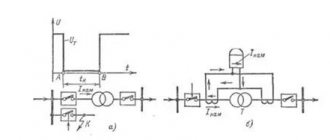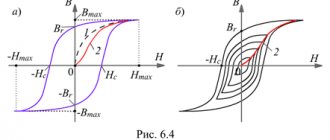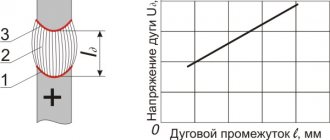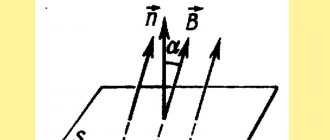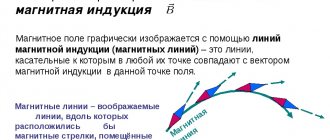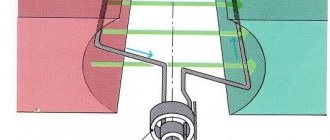The phenomenon of electromagnetic induction
When the current changes, a magnetic field is formed. This phenomenon, in turn, affects the movement of electrons.
If we consider a single wire located straight, it will create a field, the direction of the lines of force of which goes in a circle in a plane perpendicular to it.
If changes occur in the magnetic field, this increases or decreases the strength of the current that passes through the conductor. The direction of change depends on how the field changes. This phenomenon allows you to convert electrical energy into mechanical energy or vice versa.
The scientist credited with discovering the interaction of electric and magnetic fields is Michael Faraday.
Experiments were carried out that showed that a change in the magnetic field can generate the movement of electrons. This phenomenon was later called induced current.
The experiments performed by this scientist are as follows:
- Faraday made a coil with a hollow middle. Its ends were connected to a galvanometer. I picked up a magnet and placed it inside the coil. If you push it in or out, the needle on the galvanometer deflects, proving the presence of current. The faster the movement is performed, the greater its strength. A similar effect will be achieved if the magnet is stationary, but the solenoid moves.
- In the following experiment two coils were used. The big one is connected to the galvanometer, and the second one is connected to the source. One of the coils was so narrow that it could fit inside the second. If you place it there and turn the current on and off several times, the needle on the galvanometer will deflect, indicating the presence of current.
- If you take two solenoids under current and move one of them next to the other, then electron movement will also occur in them.
In such experiments, faster movement creates stronger electron movement.
Joseph Henry carried out similar research simultaneously with Faraday, but published his results later.
Explanation of the phenomenon
The movement of charge carriers - electrons - occurs when they are acted upon by an electromotive force created by a potential difference.
The emergence of a current under the influence of a change in the magnetic field occurs due to the fact that it creates a force called induced emf. Although the phenomenon of inductance was discovered by Faraday, he did not give it a theoretical explanation.
The electromagnetic field theory in physics was created by Maxwell in 1861. This phenomenon has the following features:
- the source of electron motion is an alternating magnetic field;
- its presence can be detected by the effect it produces on electrical charges;
- this field is not potential;
- field lines are closed curves.
The work of a magnetic field is expressed in the creation of an electromotive force for electrons.
Electromagnetic induction in modern technology
Slide 1
Electromagnetic induction in modern technology Performed by students of class 11 "A" MOUSOSH No. 2 of the city of Suvorov Khnykov Igor, Khudoley Andrey
Slide 2
Contents: Discovery of electromagnetic induction; Main sources of electromagnetic field; Metal detectors.
Slide 3
The phenomenon of electromagnetic induction was discovered on August 29, 1831 by Michael Faraday. The phenomenon of electromagnetic induction consists in the occurrence of an electric current in a conducting circuit, which is either at rest in a time-varying magnetic field or moves in a constant magnetic field in such a way that the number of magnetic induction lines penetrating the circuit changes.
Slide 4
The EMF of electromagnetic induction in a closed loop is numerically equal and opposite in sign to the rate of change of the magnetic flux through the surface bounded by this loop. The direction of the induced current (as well as the magnitude of the EMF) is considered positive if it coincides with the selected direction of bypassing the circuit.
Slide 5
Faraday's experiment: a permanent magnet is inserted into or removed from a coil connected to a galvanometer. When a magnet moves, an electric current arises in the circuit. Within one month, Faraday experimentally discovered all the essential features of the phenomenon of electromagnetic induction. Nowadays, anyone can conduct Faraday's experiments.
Slide 6
The main sources of the electromagnetic field The main sources of the electromagnetic field can be identified: Power lines. Electrical wiring (inside buildings and structures). Household electrical appliances. Personal computers. TV and radio broadcasting stations. Satellite and cellular communications (devices, repeaters). Electric transport. Radar installations.
Slide 7
Power lines The wires of a working power line create an electromagnetic field of industrial frequency (50 Hz) in the adjacent space (at distances of the order of tens of meters from the wire). Moreover, the field strength near the line can vary within wide limits, depending on its electrical load. In fact, the boundaries of the sanitary protection zone are established along the boundary line of maximum electric field strength, which is 1 kV/m, farthest from the wires.
Slide 8
Electrical wiring Electrical wiring includes: power supply cables for building life support systems, current distribution wires, as well as branch boards, power boxes and transformers. Electrical wiring is the main source of industrial frequency electromagnetic fields in residential premises. In this case, the level of electric field strength emitted by the source is often relatively low (does not exceed 500 V/m).
Slide 9
Household electrical appliances Sources of electromagnetic fields are all household appliances that operate using electric current. In this case, the radiation level varies within wide limits depending on the model, device design and specific operating mode. Also, the level of radiation strongly depends on the power consumption of the device - the higher the power, the higher the level of the electromagnetic field during operation of the device. The electric field strength near electrical household appliances does not exceed tens of V/m.
Slide 10
Personal computers The main source of adverse effects on the health of a computer user is the visual display device (VDI) of the monitor. In addition to the monitor and system unit, a personal computer may also include a large number of other devices (such as printers, scanners, surge protectors, etc.). All these devices operate using electric current, which means they are sources of an electromagnetic field.
Slide 11
The electromagnetic field of personal computers has a very complex wave and spectral composition and is difficult to measure and quantify. It has magnetic, electrostatic and radiation components (in particular, the electrostatic potential of a person sitting in front of a monitor can range from –3 to +5 V). Considering the fact that personal computers are now actively used in all sectors of human activity, their impact on human health is subject to careful study and control
Slide 12
Television and radio broadcasting stations A significant number of radio broadcasting stations and centers of various affiliations are currently located on the territory of Russia. Transmitting stations and centers are located in specially designated areas and can occupy fairly large areas (up to 1000 hectares). In their structure, they include one or more technical buildings where radio transmitters are located, and antenna fields on which up to several dozen antenna-feeder systems (AFS) are located. Each system includes a transmitting antenna and a feed line supplying the broadcast signal.
Slide 13
Satellite communications Satellite communications systems consist of a transmitting station on Earth and relay satellites in orbit. Satellite communication transmitting stations emit a narrowly directed wave beam, the energy flux density of which reaches hundreds of W/m. Satellite communication systems create high electromagnetic field strengths at significant distances from the antennas. For example, a 225 kW station operating at a frequency of 2.38 GHz creates an energy flux density of 2.8 W/m2 at a distance of 100 km. Energy dissipation relative to the main beam is very small and occurs most of all in the area where the antenna is directly located.
Slide 14
Cellular communications Cellular radiotelephony is one of the most rapidly developing telecommunication systems today. The main elements of a cellular communication system are base stations and mobile radiotelephones. Base stations maintain radio communication with mobile devices, as a result of which they are sources of electromagnetic fields. The system uses the principle of dividing the coverage area into zones, or so-called “cells”, with a radius of [0.5..10] km.
Slide 15
The radiation intensity of a base station is determined by the load, that is, the presence of cell phone owners in the service area of a particular base station and their desire to use the phone for a conversation, which, in turn, fundamentally depends on the time of day, location of the station, day of the week and other factors. At night, the station load is almost zero. The radiation intensity of mobile devices depends to a large extent on the state of the communication channel “mobile radiotelephone – base station” (the greater the distance from the base station, the higher the radiation intensity of the device).
Slide 16
Electric transport Electric transport (trolleybuses, trams, subway trains, etc.) is a powerful source of electromagnetic field in the frequency range [0..1000]Hz. In this case, in the vast majority of cases, the role of the main emitter is played by the traction electric motor (for trolleybuses and trams, aerial pantographs compete with the electric motor in terms of the intensity of the emitted electric field).
Slide 17
Radar installations Radar and radar installations usually have reflector-type antennas (“dishes”) and emit a narrowly directed radio beam. Periodic movement of the antenna in space leads to spatial intermittency of the radiation. Temporary intermittency of radiation is also observed, due to the cyclic operation of the radar on radiation. They operate at frequencies from 500 MHz to 15 GHz, but some special installations can operate at frequencies up to 100 GHz or more. Due to the special nature of the radiation, they can create areas with a high energy flux density (100 W/m2 or more).
Slide 18
Metal Detectors Technologically, the operating principle of a metal detector is based on the phenomenon of recording an electromagnetic field that is created around any metal object when placed in an electromagnetic field. This secondary electromagnetic field varies both in intensity (field strength) and in other parameters. These parameters depend on the size of the object and its conductivity (gold and silver have much better conductivity than, for example, lead) and, naturally, on the distance between the metal detector antenna and the object itself (depth).
Slide 19
The above technology determined the composition of the metal detector: it consists of four main blocks: an antenna (sometimes the emitting and receiving antennas are different, and sometimes it is the same antenna), an electronic processing unit, an information output unit (visual - LCD display or dial indicator, and audio - speakers or headphone jacks) and power supply.
Slide 20
Metal detectors are: Search Inspection For construction purposes
Slide 21
Search This metal detector is designed to search for all kinds of metal objects. As a rule, these are the largest models in size, cost and, naturally, in terms of functions performed. This is due to the fact that sometimes it is necessary to find objects at a depth of up to several meters in the thickness of the earth. A powerful antenna is capable of creating a high level of electromagnetic field and detecting even the slightest currents at great depths with high sensitivity. For example, a search metal detector detects a metal coin at a depth of 2-3 meters in the thickness of the earth, which may even contain ferruginous geological compounds.
Slide 22
Searchers Used by intelligence services, customs officers and security officers of various organizations to search for metal objects (weapons, precious metals, explosive wires, etc.) hidden on a person’s body and clothing. These metal detectors are distinguished by their compactness, ease of use, and the presence of modes such as silent vibration of the handle (so that the person being searched does not know that the employee conducting the search has found something). The detection range (depth) of ruble coins in such metal detectors reaches 10-15 cm.
Slide 23
Also widely used are arched metal detectors, which resemble an arch in appearance and require a person to pass through it. Ultra-sensitive antennas are laid along their vertical walls, which detect metal objects at all levels of human growth. They are usually installed in front of places of cultural entertainment, in banks, institutions, etc. The main feature of arched metal detectors is their high sensitivity (adjustable) and high speed of processing the flow of people.
Slide 24
For construction purposes This class of metal detectors, using sound and light alarms, helps builders find metal pipes, structural elements or drives located both in the thickness of walls and behind partitions and false panels. Some metal detectors for construction purposes are often combined in one device with wooden structure detectors, voltage detectors on live wires, leakage detectors, etc.
Faraday's law of electromagnetic induction
The main characteristic of a magnetic field is magnetic flux. Visually, it can be represented as lines of force penetrating a perpendicular flat figure bounded by a closed line. These lines express the magnetic induction vector.
The product of the modulus of this quantity and the area for a uniform and homogeneous magnetic field is equal to the field flux through the circuit in question.
When considering a complex field, the figure is divided into small sections in which the field is uniform and the values for each of them are summed up. To calculate in such cases, methods of differential and integral calculus are used.
Electromagnetic induction is measured in Tesla (T). This unit got its name in honor of the great physicist.
Faraday's law
quantitatively describes the effect of a magnetic field on the movement of electrons.
He states the following: the rate of change of the flow of the electromagnetic field is equal to the electromotive force generated by it, acting on the electrons and creating a current.
It should be noted that when a magnetic field is generated by a change in current strength, the resulting electromotive force affects it in the opposite way. This can be made clear with this example.
If a wire is considered and the current in it increases, then this creates a magnetic field. This, in turn, creates an EMF, which prevents the increase.
Interaction of a magnet with a circuit
As a clear example of the interaction between a magnet and a circuit, a magnet is placed in a coil made of copper wire. If a magnet is slowly inserted into the coil, the flux created by the magnet across its turns gradually increases. The ordered movement of particles in the coil that appears as a result of such manipulation will be directed clockwise, creating its own magnetic field that weakens the field of the magnet, thereby repelling it from the coil.
If the magnet is moved away from the circuit, its flux decreases, and charged particles begin to move counterclockwise, as a result of which the resulting set of magnetic force lines will attract the magnet.
On a note. In the case of an open (open) circuit: a metal or aluminum ring with a slot; coil, the turns of which are not closed through the ammeter, the power source, this pattern, like Lenz’s rule, does not work.
Lenz's rule
This rule makes it possible to correctly determine the direction of the induction current in various situations. It is formulated as follows: the direction of the current generated by induction creates such a change in the magnetic flux that prevents the change in the external field due to which it arose.
This can be illustrated with the following example. A situation will be considered when the external magnetic field increases over time, and its field lines are directed upward.
This will happen, for example, in a situation where a magnet is brought closer to a horizontal contour from below so that its north pole faces upward. In this case, the magnetic flux will increase, creating an electromotive force.
An induced current will be created in the circuit. It will be such that the magnetic lines of force are opposite to those that characterize the original. Now you can determine the direction of the induced current in the circuit.
As you know, if you look from the side of the created field, it will be directed clockwise. That is, if you look from above, the direction will be against it.
In this example you can see how using Lenz's rule you can determine the direction of the magnetic field and induced current.
Right hand rule
You probably noticed that when you change the direction of movement of the conductor in a magnetic field, the direction of deflection of the galvanometer needle also changes. Consequently, the induced electromotive force also changed its direction. There is a rule by which you can determine the direction of the induced electromotive force. This rule is called the " Right Hand Rule ".
“If the palm of the right hand is held so that the magnetic field lines enter it, and the bent thumb is aligned with the direction of movement of the conductor, then the extended four fingers will indicate the direction of the induced electromotive force.”
Self-induction
In this case, we consider a situation where a change in the movement of electrons generates an EMF, causing an induced current in the same conductor.
Taking Lenz's rule as a basis, it can be argued that it has the direction opposite to the initial change.
Self-induction is similar to the phenomenon of inertia. A heavy body cannot be stopped instantly. It is also impossible to change the current strength in one moment to the desired value due to the presence of the phenomenon of self-induction.
This property can be demonstrated by the following experiment. You need to make two electrical circuits. One of them contains a source and a light bulb. The other is made in a similar way, but the difference is that a coil is added to the circuit.
In the first circuit, after switching on, the light comes on immediately. In the second, given the presence of an inductive element, this happens with a noticeable delay.
After opening, the light in the first bulb turns off almost instantly, while in the second it turns off slowly. It is important to note that during the shutdown process the induced current may exceed the initial one. Since in this situation it is directed in the same way as the worker, the current strength may increase. In some circuits this can cause the light bulb to burn out.
Application of a magnetic field. Ampere power
Ammeter
Another discovery of Ampere is the law of the action of a magnetic field on a current-carrying conductor. It is expressed primarily in the action of a magnetic field on a coil or frame with current. Thus, a coil with current in a magnetic field is acted upon by a moment of force, which tends to rotate this coil so that its plane becomes perpendicular to the lines of the magnetic field.
The angle of rotation of the coil is directly proportional to the amount of current in the coil. If the external magnetic field in the coil is constant, then the value of the magnetic induction module is also constant. The area of the coil at not very high currents can also be considered constant; therefore, it is true that the strength of the current is equal to the product of the moment of the forces turning the coil with the current by a certain constant value under constant conditions.
l = M * const
l – current strength,
M is the moment of forces unfolding the coil with current.
Consequently, it becomes possible to measure the current strength by the angle of rotation of the frame, which is implemented in a measuring device - an ammeter.
Figure 11. Ammeter
Electric motor
After discovering the effect of a magnetic field on a current-carrying conductor, Ampere realized that this discovery could be used to make a conductor move in a magnetic field. So, magnetism can be turned into mechanical movement - to create an engine. One of the first to operate on direct current was an electric motor (Fig. 3), created in 1834 by the Russian electrical engineer B.S. Jacobi.
Figure 12. Electric motor
Let's consider a simplified model of a motor, which consists of a stationary part with magnets attached to it - the stator. Inside the stator, a frame of conductive material called a rotor can rotate freely. In order for electric current to flow through the frame, it is connected to the terminals using sliding contacts (Fig. 4). If you connect the motor to a DC source, then when the circuit is closed, the frame with current will begin to rotate.
Figure 13. Electric motor diagram
Electromagnet
It is necessary to mention one more device that works on the basis of Ampere's laws.
Ampere showed that a current-carrying coil behaves like a permanent magnet. This means that it is possible to construct an electromagnet - a device that, when an electric current passes through it, creates a magnetic field around itself.
Figure 14. Electromagnet
Figure 14.2 Example of application of electromagnets. Electromagnet in production
Maglev
A maglev, or magnetic levitation train, is a train that is held above the road surface and moved by the force of an electromagnetic field. Maglev is based on the basic property of magnets: like poles repel, and unlike poles attract.
Figure 15. Maglev
The movement of the train is carried out by a linear motor - the stator windings are turned on one by one, creating a traveling magnetic field. The train stator is drawn into this field and moves the entire train. In this case, with a frequency of 4000 times per second, the poles on the magnets change by alternating current supply. Changing the strength and frequency of the current allows you to adjust the speed of the train.
Figure 16. Maglev diagram
Maglev is the fastest land public transport. The speed record was set by the Japanese Shinkansen train L0 in April 2015 - it accelerated to 603 km/h.
Figure 17. Shinkansen L0
Telegraph
It was Ampere who came up with the idea that by combining conductors and magnetic needles, one could create a device that transmits information over a distance.
Figure 18. Electric telegraph
The idea of the telegraph arose in the first months after the discovery of electromagnetism.
However, the electromagnetic telegraph became widespread after Samuel Morse created a more convenient device and, most importantly, developed a binary alphabet consisting of dots and dashes, which is called Morse code.
From the transmitting telegraph apparatus, using a “Morse key” that closes the electrical circuit, short or long electrical signals corresponding to dots or dashes of Morse code are generated in the communication line. On a receiving telegraph apparatus (writing instrument), while the signal (electric current) is passing, an electromagnet attracts an armature, to which a metal writing wheel or scribe is rigidly connected, which leaves an ink mark on the paper tape (Fig. 7).
Figure 19. Telegraph operation diagram
Gauss gun
The mathematician Gauss, having become acquainted with Ampere's research, proposed creating an original cannon operating on the principle of the action of a magnetic field on an iron ball or rod - a projectile: in a cylindrical winding (solenoid), when an electric current flows through it, a magnetic field arises. This magnetic field begins to draw the projectile into the solenoid, which begins to accelerate. If at the moment when the projectile is in the middle of the winding, the current in the latter is turned off, then the retracting magnetic field will disappear and the projectile, having gained speed, will freely fly out through the other end of the winding.
Figure 20. Gauss gun
Speaker
The Ampere force is also used in speakers, whose operating principle is based on the action of the magnetic field of a permanent magnet on an alternating current in a moving coil: the coil, through which a modified audio frequency current flows, oscillates in the magnetic field of the magnet. Together with the coil, the diffuser vibrates, emitting sound.
Figure 21. Speaker structure
Figure 22. Speaker (appearance)
Lorentz force
Kinescope - television tube, cathode ray tube
The effect of a magnetic field on a moving charge is widely used in technology. It is enough to mention television tubes (= picture tubes), in which electrons flying towards the screen are deflected using a magnetic field created by special coils. Otherwise, a television tube can be called a cathode ray tube.
Figure 23. Kinescope
Mass spectrograph
Another application of the magnetic field has been found in devices that make it possible to separate charged particles according to their specific charges, i.e. based on the ratio of the charge of a particle to its mass, and from the results obtained accurately determine the mass of the particles. Such devices are called mass spectrographs. The figure shows a schematic diagram of a simple mass spectrograph.
The vacuum chamber of the device is placed in a magnetic field (induction vector B is perpendicular to the figure). Charged particles (electrons or ions) accelerated by an electric field, having described an arc, fall on a photographic plate, where they leave a trace that makes it possible to measure the radius of the trajectory r . This radius determines the specific charge of the ion. Knowing the charge of an ion, it is easy to calculate its mass. Explore
the chemical composition of soil taken on the Moon, for example, will be helped by the same mass spectrum.
Cyclotron - charged particle accelerator
Figure 25 shows the movement of charged particles in the vacuum chamber of a cyclotron.
A vacuum chamber is placed between the poles of a strong electromagnet, in which there are two electrodes in the form of hollow metal half-cylinders ( dees ). An alternating electrical voltage is applied to the dees, the frequency of which is equal to the cyclotron frequency. Charged particles are injected into the center of the vacuum chamber. The particles are accelerated by the electric field in the gap between the dees. Inside the dees, the particles move under the influence of the Lorentz force in semicircles, the radius of which increases as the energy of the particles increases.
Every time a particle flies through the gap between the dees, it is accelerated by the electric field. Thus, in a cyclotron, as in all other accelerators, a charged particle is accelerated by an electric field and kept on its trajectory by a magnetic field. Cyclotrons make it possible to accelerate protons to energies of the order of 20 MeV.
Figure 25.2. Cyclotron (appearance)
Synchrophasotron
In 1957, the Soviet Union made a revolutionary scientific breakthrough in two directions at once: in October the first artificial Earth satellite was launched, and a few months earlier, in March, the legendary synchrophasotron, a giant installation for studying the microworld, began operating in Dubna. These two events shocked the whole world, and the words “satellite” and “synchrophasotron” became firmly established in our lives.
Synchrophasotron is a cyclic resonant accelerator of charged particles. Cyclic means that particles circulate along a closed path, which is formed by magnetic fields. Resonant - that there is a high-frequency electromagnetic resonator on the ring, in which an electric field wave is pumped by an external generator; a bunch of particles passes this resonator at each revolution synchronously with the field oscillation, and this electric field lightly accelerates it in a resonant manner (like a mother lightly pushes a swing, achieving high speed). Thus, an electric field with an amplitude of tens of kilovolts can accelerate particles up to tens of giga(electron)volts.
Figure 26. Synchrophasotron (scheme)
Figure 26.2. Synchrophasotron (appearance)
Magnetron
A magnetron is a powerful electron tube that generates microwaves when a flow of electrons interacts with a magnetic field.
Magnetrons can operate at various frequencies from 0.5 to 100 GHz, with powers from several W to tens of kW in continuous mode, and from 10 W to 5 MW in pulsed mode with pulse durations mainly from fractions to tens of microseconds.
Magnetrons have high efficiency (up to 80%), that is, they are capable of converting up to 80% of the electricity supplied to them into a microwave field.
Magnetrons can be either non-tunable or tunable in a small frequency range (usually less than 10%). For slow frequency tuning, hand-driven mechanisms are used; for fast frequency tuning (up to several thousand tunings per second), rotary and vibration mechanisms are used.
Magnetrons as ultrahigh frequency generators are widely used in modern radar technology.
Figure 27. Magnetron (circuit)
Magnetic field in medicine
Magnetic fields are widely used in medicine. There is also a special term – magnetic therapy.
Magnetotherapy is a method of physiotherapy, which is based on the effect on the body of magnetic fields of various parameters.
For therapeutic and prophylactic purposes the following are used:
- constant magnetic field (permanent magnetotherapy);
- pulsed magnetic field (pulse magnetotherapy);
- alternating magnetic field (low-frequency magnetic therapy).
Permanent magnetic therapy
With constant magnetic therapy, the body is exposed to a constant magnetic field for therapeutic and prophylactic purposes. To obtain a constant magnetic field (PMF), permanent magnets from various materials and various designs are used, as well as electromagnets with or without ferromagnetic cores, in the windings of which a constant electric current flows. The induction of constant magnetic fields is often 30-60 mT.
Magnetrons as ultrahigh frequency generators are widely used in modern radar technology.
Inductance
A conductor through which a changing current passes is capable of storing energy through the use of a magnetic field. For a straight piece of wire this ability is insignificant.
However, if we are talking about a coil, then its magnitude is much stronger. This characteristic is called inductance. It is designated as “L” and plays an important role in determining various characteristics of the electromagnetic field.
The magnetic flux in a certain circuit can be expressed using the formula Ф = L* I, and the electromotive force in the form E = L* (dI/dt).
The current passing through the circuit is capable of creating an electromagnetic field, and it will be stronger the faster its changes occur.
In practice, to increase the inductance of the coil, ferromagnetic rods inserted inside are used.
Continuation of experiments
But that's not all the scientist did. Since the magnetic and electric fields are closely related, it was necessary to find out how much.
To do this, Faraday supplied current to one winding and pushed it inside another similar winding with a radius larger than the first. Once again electricity was induced. Thus, the scientist proved: a moving charge generates both electric and magnetic fields at the same time.
It is worth emphasizing that we are talking about the movement of a magnet or magnetic field inside a closed loop of a spring. That is, the flow must change all the time. If this does not happen, no current is generated.
Magnetic field energy
Electric current creates a magnetic field. In doing so, he expends a certain amount of energy. Its value is equal to the work that was spent on creating the field. It is calculated using the following formula:
The following notations were used here:
- W – magnetic field energy;
- L – inductance;
- I – current strength.
If the magnetic field disappears for some reason, its energy will be released in one form or another.
Magnetic flux
Corrugated pipe
This phenomenon, magnetic flux, is a set of lines of force passing through a certain cross-section of a conductor or a closed conductive circuit.
The module of this quantity Ф is calculated using the following formula:
Ф= B×S×Cos α, where:
- B is the module of the vector of induction created by the power lines;
- S is the surface area through which the flow of field lines passes;
- α – the angle between the vectors of the induction lines of force and the normal (i.e., perpendicular to the plane pierced by the magnetic lines of force).
This value is measured in Webers (Wb).
Application of electromagnetic induction
This phenomenon is actively used in various spheres of human society.
Below are some of the most famous examples:
- radio broadcasting is impossible without using the phenomenon of electromagnetic induction;
- in medicine, magnetic therapy is one of the effective treatment methods;
- in fundamental research, synchrophasotrons are used to accelerate elementary particles, the operation of which is based on the phenomenon of inductance;
- electricity meters used in everyday life to account for electricity use the phenomenon under consideration;
- in order to transmit electrical energy produced by power plants over long distances, transformers are used, the operation of which is based on the use of electromagnetic induction;
- In metallurgy, induction furnaces are used to melt metal.
The use of this phenomenon is very widespread. The examples given are just a sampling of the various use cases.
Basic formulas
The basic formulas for the phenomenon of magnetic induction are shown in the figure below.
Basic formulas describing the phenomenon of electromagnetic induction
Having understood the essence of the phenomenon of electromagnetic induction, you can understand how electric motors and generators work. This knowledge, in addition to its great theoretical value, has quite a useful practical application, allowing you to independently find, and in some cases eliminate, unit malfunctions without resorting to the expensive services of specialists.
All formulas on the topic “Electromagnetic induction”
In order to briefly refresh your memory of the formulas related to magnetic induction, the following is a list of the most important of them.
The discovery of the laws that describe the behavior of the electromagnetic field is one of the most important scientific achievements in history. In modern life, the use of this phenomenon occurs in almost all areas of society.
Magnetic or electric?
In the early nineteenth century, scientists figured out how to produce direct current. The first primitive battery was created. It was enough to send a stream of electrons through metal conductors. Thanks to the first source of electricity, a number of discoveries were made.
In 1820, the Danish scientist Hans Christian Oersted found out that the magnetic needle deviates near a conductor connected to the network. The positive pole of the compass is always located in a certain way in relation to the direction of the current. The scientist carried out experiments in all possible geometries: the conductor was above or below the arrow, they were located parallel or perpendicular. The result was always the same: the switched on current set the magnet in motion. This was how the discovery of the phenomenon of electromagnetic induction was anticipated.
But the idea of scientists must be confirmed by experiment. Immediately after Oersted's experiment, the English physicist Michael Faraday asked the question: “Do the magnetic and electric fields simply influence each other, or are they more closely related?” The scientist was the first to test the assumption that if an electric field causes a magnetized object to deviate, then the magnet should generate a current.
The experimental design is simple. Now any schoolchild can repeat it. A thin metal wire was coiled into the shape of a spring. Its ends were connected to a device that recorded the current. When a magnet moved next to the coil, the device’s arrow showed the voltage of the electric field. Thus, Faraday's law of electromagnetic induction was derived.
Properties of induction
Induction is actively used in all scientific fields, since it is of great importance when it is necessary to move from empirical knowledge to theoretical knowledge. Various experiments are often carried out. Thanks to this, it is possible to collect individual facts that are carefully analyzed. On this basis an inductive conclusion is built. The need for such conclusions lies in the fact that they guarantee the transition from rare facts to general, but maximally developed provisions. One can trace some connection between the desire to create an accurate description of a hypothesis and move on to generalizations.
In physics, special attention is paid to induction of the scientific type, since it is distinguished by the search for causal connections between a phenomenon and the desire to identify the existing signs of objects combined into a class. Scientific induction is divided into 3 categories:
- Search and study of causal relationships. The totality of circumstances that precede the observed phenomenon is taken into account.
- Filtering cases. Unlike basic induction, when only the number of situations under study is taken into account, careful selection of cases implies that the characteristics of each of the analyzed groups will be taken into account. This approach allows you to better understand all the parameters of the EMF.
- Scientific induction can be built not only on the basis of the analysis of a number of phenomena and objects. To achieve the desired result, a single representative of the group must be studied. Individual properties that make an object stand out among other representatives of the same category are not taken into account.
These types of induction are of great importance in the scientific community. With the right approach, you can significantly speed up the search for the correct answer, find out the basic values and discover patterns. This approach allows you not to wait until all the phenomena of the analyzed class are studied in detail.
Magnetic resonance imaging
It is worth mentioning the use of magnetic fields in medicine, such as magnetic resonance imaging. It is used to study internal organs and human tissues in order to diagnose various diseases. The principle of its operation is based on the use of the phenomenon of short-term resonance of protons in an electromagnetic field to visualize tissues depending on the presence of water in them.
Figure 31. Magnetic resonance imaging
Conclusion
So, we can come to the conclusion that the development of modern civilization is difficult to imagine without the widespread use of magnetic materials and magnetic fields. A significant effect of using magnetic fields and materials has been achieved in science: this is the use of nuclear magnetic resonance methods, the use of a magnetic field to accelerate elementary particles, etc.
Magnetic fields are effectively used in medicine - for therapy, diagnostics, healing, etc. And the applications in various technical devices and household appliances can be listed endlessly. And this is only an incomplete list of applications of the magnetic field. And there are even more amazing discoveries of magnetic properties, new magnetic materials and unique applications of the magnetic field in science, industry, transport, medicine, etc. ahead.




